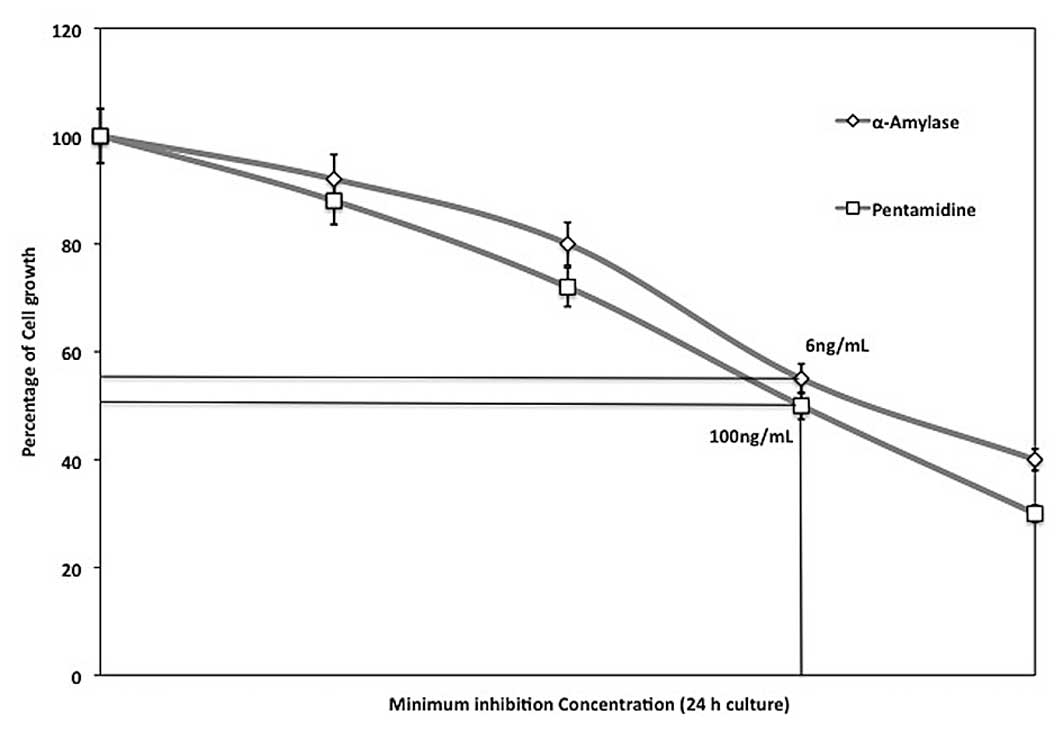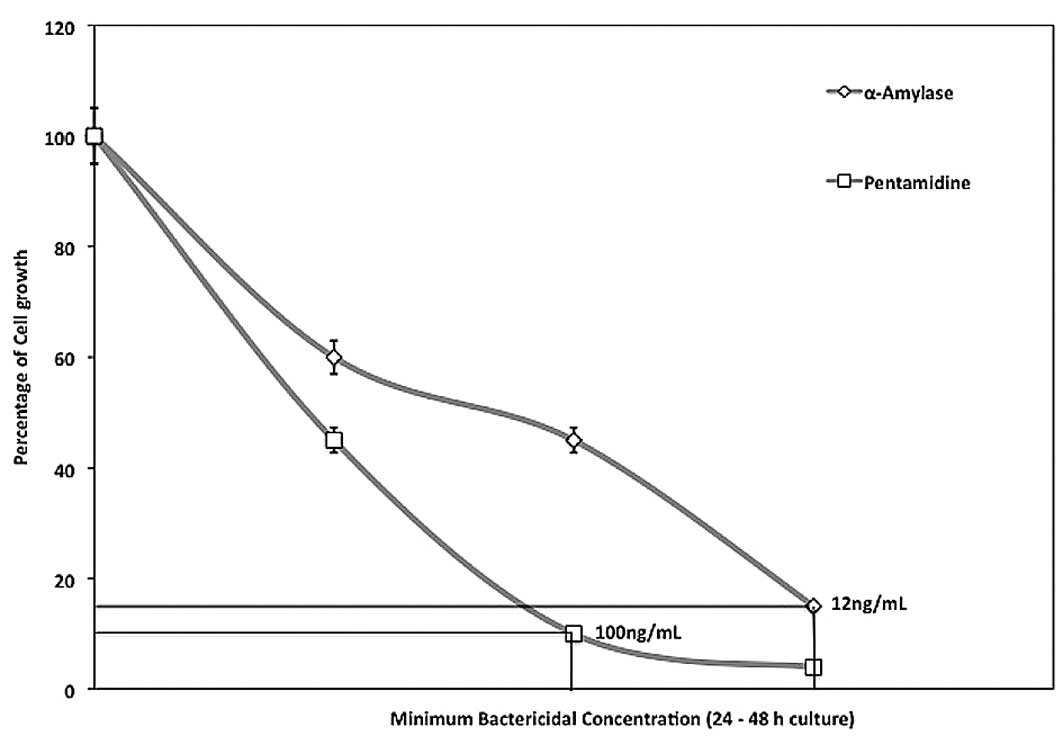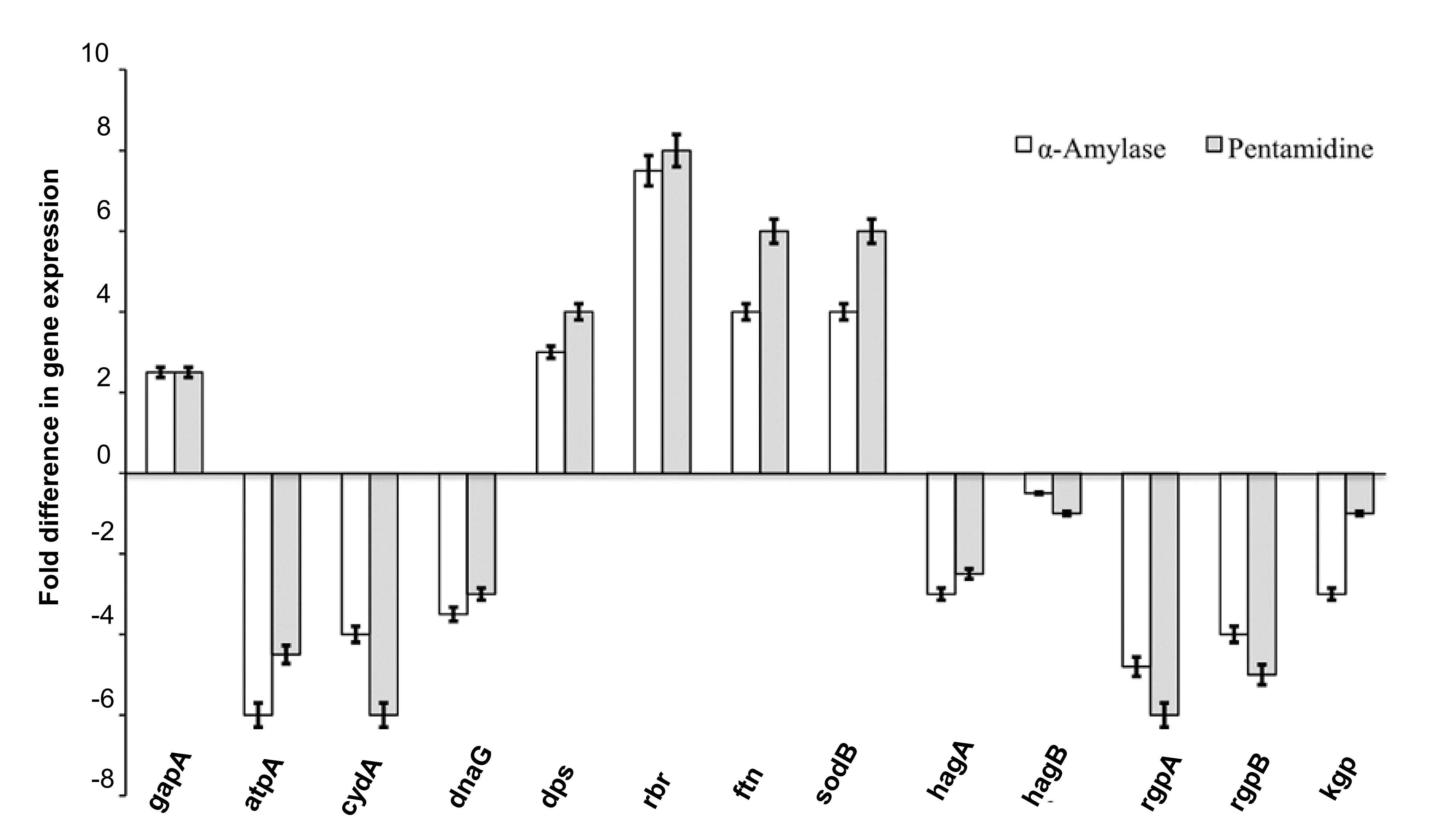Attenuation of Porphyromonas gingivalis oral infection by α‑amylase and pentamidine
- Authors:
- Published online on: April 1, 2015 https://doi.org/10.3892/mmr.2015.3584
- Pages: 2155-2160
Abstract
Introduction
Porphyromonas gingivalis (P. gingivalis) is a Gram-negative, rod-shaped, anaerobic pathogenic bacterium associated with several periodontal diseases (1). The occurrence of periodontitis in >47% of the US population, with a high prevalence of mild (8.7%), moderate (30%) and severe (8.5%) cases, is due to variables, such as oral hygiene, socioeconomic status and other environmental, genetic and metabolic risk factors (2). P. gingivalis exhibits a strong positive association with the diagnostic parameters of periodontitis, including gingival recession, increased sulcular pocket depth and bleeding upon probing (3). In addition, Hajishengallis et al (4) demonstrated that although P. gingivalis does not independently cause periodontal disease in a germ-free murine model, low numbers of P. gingivalis are able to disrupt host homeostasis through actions involving commensal microorganisms and complement, leading to inflammation and periodontal disease (4).
P. gingivalis produces multiple virulence factors that allow successful colonization and support evasion of host defenses, a number of which contribute to the inflammation and destruction of host tissues (5). Adhesins, such as fimbraie and hemagglutinins, promote attachment (5,6) and proteolytic enzymes, such as cysteine proteinases and hemagglutinins, are capable of degrading multiple substrates in the gingival crevice, facilitating nutrient acquisition and contributing to host tissue degradation (5,6).
The control of oral bacteria is mediated by a diverse array of specific and non-specific innate immune molecules present in saliva and on mucosal surfaces (7). There are number of functional families consisting of >45 antimicrobial proteins and peptides, including cationic peptides, metal ion chelators, histatins, defensins, bacterial adhesions and agglutinators and enzymes directed at the bacterial cell wall. However, the physiological concentration of the majority of salivary antimicrobial proteins and peptides is lower than the effective concentration in vivo (7), which suggests that there may be additional immune functions within the saliva.
The enzyme α-amylase catalyzes the hydrolysis of internal α-1,4-glycosidic linkages within carbohydrate moieties, including glucose, maltose and maltotriose units (8,9). α-amylases are used in a number of industrial processes in the food, fermentation, textiles, paper, detergent and pharmaceutical industries. Fungal and bacterial amylases may have the potential for use in the pharmaceutical and fine-chemical industries. Advances in biotechnology have led to the expansion of amylase application in numerous fields, such as biomedical and analytical chemistry, and also textiles, food, brewing and distilling industries (8,10).
The bisbenzamidine derivative, pentamidine, has proved one of the most successful agents for targeting eukaryotic parasites, and has been used clinically for >70 years (11,12). In 1938, pentamidine isethionate was identified to have anti-protozoal activity, and was approved in the United States for the treatment of Pneumocystis carinii pneumonia and other protozoal diseases (13). Pentamidine has the ability to inhibit interaction at the Ca2+/p53 site of the protein, and has been reported to inhibit S100B activity (14). On the basis of the previous studies, the present study aimed to take advantage of the antimicrobial activity of α-amylase and pentamidine to attenuate oral infection of P. gingivalis.
Materials and methods
Reagents and chemicals
α-amylase from porcine pancreas was purchased from Sigma-Aldrich (St. Louis, MO, USA). The bisbenzamidine derivative, pentamidine was purchased from Sanofi S.A. (Paris, France). The media (Terrific broth and Luria-Bertani broth) were obtained from Thermo Fisher Scientific (Pittsburgh, PA, USA). The modified BacTiter-Glo Microbial Cell Viability Assay kit (Promega Corporation, Madison, WI, USA) was purchased for the determination of minimum inhibition concentration (MIC). The polymerase chain reaction (PCR) reagents were obtained from Bio-Rad Laboratories (Hercules, CA, USA), and Invitrogen Life Technologies (Carlsbad, CA, USA).
Bacterial culture
Porphyromonas gingivalis ATCC 33277 was purchased from the German Collection of Microorganisms and Cell Cultures (DSMZ; Braunschweig, Germany). The cells were cultured in modified Gifu anaerobic medium (GAM) broth (Nissui, Tokyo, Japan), in an aerobic jar and in the presence of a deoxygenating reagent (AnaeroPack; Mitsubishi Gas Chemical Company, Inc., Tokyo, Japan) for 48 h at 37°C. Cell concentration was standardized by measuring optical density at 650 nm using a Lumetron colorimeter (Photovolt Corp., Indianapolis, IN, USA).
MIC and minimum bactericidal concentration (MBC) assay
MICs were determined with modifications for each organism according to methods described by Cole et al (15). In brief, the appropriate growth medium for P. gingivalis was used to prepare 5-ml overnight cultures to an exponential phase. Bacteria were adjusted to a concentration of 4.5×105 colony-forming units/ml, added to various concentrations of antibiotic in 96-well plates, and incubated at 37°C for a period of 18–24 h in a humidified container. The MIC was defined as the lowest concentration that prevented 50% growth of cells. MBCs were determined by plating the wells with concentrations of 50–200% MIC. Following 24–48-h growth, the MBC was determined as the lowest concentration that did not permit visible growth on the surface of the agar. All MIC assays were performed in triplicate.
Scanning electron microscopy (SEM)
P. gingivalis cultures were grown to the mid-log phase, and 10 ml cell suspension [1×104 cells/ml in modified GAM supplemented with α-amylase (12 ng/ml) or pentamidine (100 ng/ml)] was incubated at 37°C for 2 h prior to collection and fixed in 2.5% glutaraldehyde. The samples were dehydrated with graded ethanol and t-butanol, dried using the critical point method and coated with gold. Cells were observed under a JSM-6510 LV scanning electron microscope (JEOL, Ltd., Tokyo, Japan).
Determination of differential gene expression
The differential gene expression was determined by quantitative (q) PCR. The bacterial culture (P. gingivalis) grown to early exponential phase was adjusted to an optical density 600 of 0.1 and split into two groups. One half was left untreated, while the other half was treated with α-amylase (12 ng/ml) and pentamidine (100 ng/ml). Following anaerobic incubation for 2 h, the cells were harvested, and total RNA was extracted using TRIzol reagent (Invitrogen Life Technologies, Carlsbad, CA, USA). cDNA was synthesized with 1 µg total RNA using the SuperScript II reverse transcriptase (Invitrogen Life Technologies). To identify the expression value of genes associated with hemagglutination, hemolysis, proteolysis, hemin uptake, chromosome replication, energy production, iron storage and oxidative stress, qPCR was performed using specific primers for the selected genes (Table I). The housekeeping gene glyceraldehyde 3-phosphate dehydrogenase (gapA) was used as a control gene. qPCR was conducted using the MiniOpticon Real-Time PCR Detection system (Bio-Rad Laboratories) with a reaction mixture containing 10 µl iQ SYBR Green Supermix (Bio-Rad Laboratories), 1 µl cDNA and primers to a final concentration of 250 nm in a final volume of 20 µl. To confirm that a single PCR product was amplified, a melting curve analysis was performed under the following conditions: 65°C to 95°C, with a heating rate of 0.2°C/sec. All quantifications were normalized to the P. gingivalis 16S ribosomal RNA gene.
Results
Minimum inhibition and bactericidal concentration assay
The minimum inhibitory activity against P. gingivalis ATCC 33277 cell growth was measured using differential concentrations of α-amylase (2, 4, 6 and 8 ng/ml) and pent-amidine (50, 75, 100 and 125 ng/ml). The concentrations that prevented 50% growth of cells observed for 24 h were considered to be the MIC and were determined as 6 and 100 ng/ml α-amylase and pentamidine, respectively (Fig. 1). The MBC was tested using concentrations of 50–200% MIC and cells were cultured for 24–48 h. The MBCs were determined as 12 and 100 ng/ml for α-amylase and pentamidine, respectively (Fig. 2). This is the lowest concentration that did not permit visible growth on the surface of the agar, suggesting that P. gingivalis cells underwent significant cellular damage.
SEM analysis
SEM results demonstrated that P. gingivalis cells treated with α-amylase (Fig. 3A) or pentamidine (Fig. 3B) exhibited various stages of lysis. Cellular debris and detached pieces of membrane lay adjacent to the cells. A number of cells were distorted with irregular morphology and loss of cellular content. In addition, the cells were more closely aggregated and increased numbers of external blebs were present on and around the bacteria compared with those in controls (Fig. 3A). Similar to α-amylase-treated bacteria, pentamidine-treated P. gingivalis (Fig. 3B) was also distorted with irregular morphology and presented various stages of lysis with loss of intracellular content. Untreated P. gingivalis (Fig. 3C) cells exhibited an external structure typical of a healthy Gram-negative coccobacillus 7 bacterium with multiple blebs present on the cell surface.
Determination of differential gene expression
Following determination of the MBC, differential gene expression was investigated by exposing the culture to the MBC. The genes associated with iron storage (dps, rbr and ftn) and oxidative stress (sodB) were indicated to have upregulated expression levels, while levels of genes encoding gingipains (rgpA, rgpB and kgp) and hemagglutinins (hagA and hagB) were downregulated by α-amylase and pentamidine (Fig. 4). The inhibitors also downregulated the expression of genes associated with energy production (atpA and cydA) and chromosome replication (dnaG). The expression levels of the control gene gapA were not significantly affected.
Discussion
In the current study, two potent inhibitors of the P. gingivalis species (α-amylase and pentamidine) were investigated. These amylases, which are endogenous to saliva and oral mucosa are antimicrobial for P. gingivalis, and induce structural damage. α-amylase and pentamidine demonstrated significant inhibitory activity against P. gingivalis cell growth, and had MICs of 6 and 100 ng/ml, respectively. Similarly, the MBCs of α-amylase and pentamidine were determined as 12 and 100 ng/ml, respectively. SEM analysis suggested that the cell membrane structure of bacterial cells was compromised, likely resulting from damage caused by the inhibitors. However, the nature and mechanisms of action of the inhibitors remain unclear.
The results of the present study are in agreement with growing evidence that pentamidine kills bacteria in a dose-dependent manner and induces cellular damage. For example, E. coli and S. aureus treated with sphingosine, phytosphingosine or dihydrosphingosine exhibit extensive and differential intracellular and extracellular damage (16). Bibel et al (17) also demonstrated that sphinganine (dihydrosphingosine) treatment of S. aureus results in ultrastructural damage similar to antibiotic treatment, including lesions of the cell wall, membrane evaginations and leakage. In addition, treatment of Helicobacter pylori with oleic or linoleic acid results in altered morphology, with a disruption of cellular membranes and cell lysis (18). The present study indicates that there may be different mechanisms underlying the actions of different inhibitors. Antimicrobial activity and ultrastructural damage are dependent upon the specific lipid treatment. These data, combined with a previous observation that fatty acids and sphingoid bases exhibit differential activity across bacterial species (19), suggest that the antimicrobial activity of fatty acids and sphingoid bases is a specific interaction that depends upon characteristics of the bacterium and a particular lipid. The current study indicates that the mechanisms for the antimicrobial activity of α-amylase and pentamidine against bacteria involve membrane disruption by detergent activity and incorporation of lipids into the bacterial plasma membrane.
Surface-accumulated hemin is transported into bacterial cells so that it can be utilized. To evaluate the effect of α-amylase and pentamidine on P. gingivalis, the expression levels of selected genes were analyzed to determine whether they were up- or downregulated. The genes associated with iron storage (dps, rbr and ftn) and oxidative stress (sodB) presented upregulated expression levels. Notably, pentamidine increased the level of cell-associated hemin, which suggests that surplus hemin is accumulated on the bacterial cell surface regardless of energy-driven transport in the presence of pentamidine. A small decrease in the level of kgp was observed, the suppressed formation of µ-oxo bisheme may be explained by the fact that RgpA or RgpB, or the two together, with kgp activity are required by P. gingivalis to produce µ-oxo bisheme (20). The formation of µ-oxo bisheme represents an oxidative buffer mechanism for inducing an anaerobic miroenvironment and protects from hemin-mediated cell damage (20,21). Therefore, excessive accumulation of hemin in the vicinity of the bacterial cell surface without formation of µ-oxo bisheme by the bacterium may cause oxidative stress on P. gingivalis. This expectation was confirmed by qPCR, which indicated upregulation of the genes involved in oxidative stress, such as dps, rbr, ftn and sodB. An oxidative-stress-like phenomenon is one of the shared downstream events leading to bacterial cell death initiated by bactericidal antibiotics (22). Additionally, during bacterial cell death, genes for energy production, chromosome replication and nucleotide metabolism have been demonstrated to be inactivated (23). Therefore, the observation of the oxidative-stress-like response of P. gingi-valis and decreased expression of the genes required for ATP synthesis and chromosome replication of the bacterium grown with α-amylase and pentamidine in the current study may also support the idea that these inhibitors have a bactericidal effect.
In conclusion, the present study demonstrated that the use of the growth inhibitors α-amylase and pentamidine for controlling bacterial infection and aiding the innate immune system, in addition to promoting gene expression, may be an effective strategy for the prevention and treatment of oral cavity infection. Following comparison of these two inhibitors, pentamidine was demonstrated to be more effective at inhibiting the growth of P. gingivalis cells. However, further investigation is required to investigate its suitability for use in humans.
References
|
Darveau RP, Tanner A and Page RC: The microbial challenge in periodontitis. Periodontol 2000. 14:12–32. 1997. View Article : Google Scholar : PubMed/NCBI | |
|
Eke PI, Dye BA, Wei L, et al CDC Periodontal Disease Surveillance Workgroup: Prevalence of periodontitis in adults in the United States: 2009 and 2010. J Dent Res. 91:914–920. 2012. View Article : Google Scholar : PubMed/NCBI | |
|
Hutter G, Schlagenhauf U, Valenza G, et al: Molecular analysis of bacteria in periodontitis: evaluation of clone libraries, novel phylotypes and putative pathogens. Microbiology. 149:67–75. 2003. View Article : Google Scholar : PubMed/NCBI | |
|
Hajishengallis G, Liang S, Payne MA, et al: Low-abundance biofilm species orchestrates inflammatory periodontal disease through the commensal microbiota and complement. Cell Host Microbe. 10:497–506. 2011. View Article : Google Scholar : PubMed/NCBI | |
|
Holt SC, Kesavalu L, Walker S and Genco CA: Virulence factors of Porphyromonas gingivalis. Periodontol 2000. 20:168–238. 1999. View Article : Google Scholar : PubMed/NCBI | |
|
Lamont RJ and Jenkinson HF: Subgingival colonization by Porphyromonas gingivalis. Oral Microbiol Immunol. 15:341–349. 2000. View Article : Google Scholar | |
|
Gorr SU: Antimicrobial peptides in periodontal innate defense. Front Oral Biol. 15:84–98. 2012. | |
|
Gupta R, Gigras P, Mohapatra H, et al: Microbial α-amylases: a biotechnological perspective. Process Biochem. 38:1599–1616. 2003. View Article : Google Scholar | |
|
Rajagopalan G and Krishnan C: Alpha-amylase production from catabolite derepressed Bacillus subtilis KCC103 utilizing sugarcane bagasse hydrolysate. Bioresour Technol. 99:3044–3050. 2008. View Article : Google Scholar | |
|
Pandey A, Nigam P, Soccol CR, et al: Advances in microbial amylases. Biotechnol Appl Biochem. 31(Pt 2): 135–152. 2000. View Article : Google Scholar : PubMed/NCBI | |
|
Burchmore RJ, Ogbunude PO, Enanga B and Barrett MP: Chemotherapy of human African trypanosomiasis. Curr Pharm Des. 8:256–267. 2002. View Article : Google Scholar : PubMed/NCBI | |
|
Wilson WD, Tanious F, Mathis A, et al: Antiparasitic compounds that target DNA. Biochimie. 90:999–1014. 2008. View Article : Google Scholar : PubMed/NCBI | |
|
Pearson RD and Hewlett EL: Pentamidine for the treatment of Pneumocystis carinii pneumonia and other protozoal diseases. Ann Intern Med. 103:782–786. 1985. View Article : Google Scholar : PubMed/NCBI | |
|
Charpentier TH, Wilder PT, Liriano MA, et al: Divalent metal ion complexes of S100B in the absence and presence of pent-amidine. J Mol Biol. 382:56–73. 2008. View Article : Google Scholar : PubMed/NCBI | |
|
Cole AM, Weis P and Diamond G: Isolation and characterization of pleurocidin, an antimicrobial peptide in the skin secretions of winter flounder. J Biol Chem. 272:12008–12013. 1997. View Article : Google Scholar : PubMed/NCBI | |
|
Fischer CL, Walters KS, Drake DR, et al: Sphingoid bases are taken up by Escherichia coli and Staphylococcus aureus and induce ultrastructural damage. Skin Pharmacol Physiol. 26:36–44. 2013. View Article : Google Scholar : | |
|
Bibel DJ, Aly R, Shah S and Shinefield HR: Sphingosines: antimicrobial barriers of the skin. Acta Derm Venereol. 73:407–411. 1993.PubMed/NCBI | |
|
Khulusi S, Ahmed HA, Patel P, Mendall MA and Northfield TC: The effects of unsaturated fatty acids on Helicobacter pylori in vitro. J Med Microbiol. 42:276–282. 1995. View Article : Google Scholar : PubMed/NCBI | |
|
Fischer CL, Drake DR, Dawson DV, et al: Antibacterial activity of sphingoid bases and fatty acids against Gram-positive and Gram-negative bacteria. Antimicrob Agents Chemother. 56:1157–1161. 2012. View Article : Google Scholar : | |
|
Smalley JW, Birss AJ, Szmigielski B and Potempa J: The HA2 haemagglutinin domain of the lysine-specific gingipain (Kgp) of Porphyromonas gingivalis promotes micro-oxo bishaem formation from monomeric iron(III) protoporphyrin IX. Microbiology. 152:1839–1845. 2006. View Article : Google Scholar : PubMed/NCBI | |
|
Lewis JP, Dawson JA, Hannis JC, Muddiman D and Macrina FL: Hemoglobinase activity of the lysine gingipain protease (Kgp) of Porphyromonas gingivalis W83. J Bacteriol. 181:4905–4913. 1999.PubMed/NCBI | |
|
Wright GD: On the road to bacterial cell death. Cell. 130:781–783. 2007. View Article : Google Scholar : PubMed/NCBI | |
|
Asakura Y and Kobayashi I: From damaged genome to cell surface: transcriptome changes during bacterial cell death triggered by loss of a restriction-modification gene complex. Nucleic Acids Res. 37:3021–3031. 2009. View Article : Google Scholar : PubMed/NCBI |













